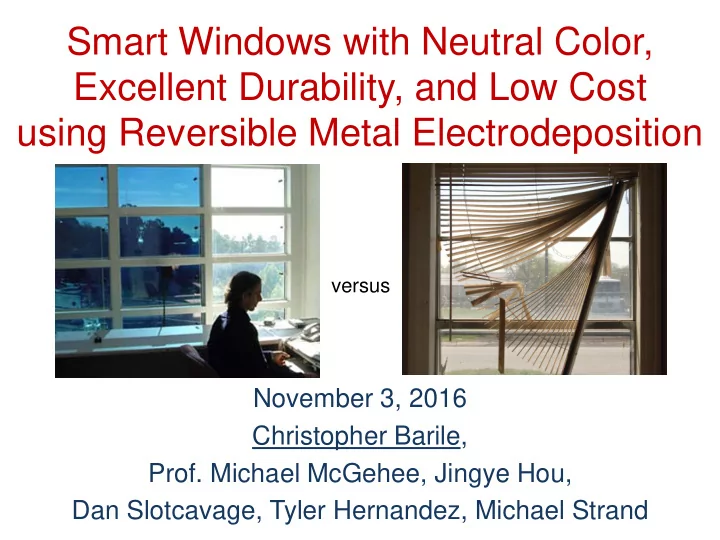

Smart Windows with Neutral Color, Excellent Durability, and Low Cost using Reversible Metal Electrodeposition versus November 3, 2016 Christopher Barile, Prof. Michael McGehee, Jingye Hou, Dan Slotcavage, Tyler Hernandez, Michael Strand
The Potential of Smart Windows Transparent • Dynamically control solar radiation • Buildings used 40% of U.S. electricity in 2015 • 20% energy savings for lighting, cooling, and heating • Car windows, sunglasses SAGE Windows, Chabot College, Hayward, CA Tinted U.S. Energy Information Administration, 2015. View Glass, Energy Savings Guide, http://viewglass.com/assets/pdfs/workplace-white-paper.pdf
Electrochromic Devices • Materials that change color with voltage • Transition metal oxides x Li + + x e - + WO 3 Li x WO 3 colorless blue Mortimer, R. J. Ann. Rev. Mater. Res. 2011 , 41 , 241.
Drawbacks of Electrochromics • Not color neutral • Absorptive poor heat management • Expensive due to multiple layers (≥ 4) • Difficult to scale • Cycle life (need > 10,000) WO 3 Electrochromic Boeing 787 Dreamliner Thakur, V. K. et al. Adv. Mater. 2012 , 24 , 4071.
Reversible Metal Electrodeposition Cathode: M + + e - M (window) Cathode: Transparent conducting Electrolyte M (frame) M + + e - Anode: substrate on containing M + glass M (frame) M (window) Net: Anode: Metal counter electrode around glass • Only ~20 nm metal required for complete opacity • Reflective First Prototypes: M = Cu-Pb, Cu-Ag
Metal Deposition from a Cu-Pb System 0 s 30 s 60 s Visible Infrared -0.35 V deposition, ITO on glass working, Pt counter, Ag/AgCl reference electrodes
Metal Deposition from a Cu-Pb System 0 s 120 s Transparent Transparent 90 s 30 s 60 s Opaque Visible Infrared -0.35 V deposition, Good Resting Stability +0.45 V stripping ITO on glass working, Pt counter, Ag/AgCl reference electrodes
Morphology on Pt-modified ITO 200 nm 200 nm 200 nm 55% Transmission 30% Transmission 5% Transmission Increasing Deposition Time
Smart Window Reliability Pt-modified ITO/glass electrode Maximum Transmission Minimum Transmission Each cycle: -0.35 V for 60 s, +0.45 V for 60 s
Morphology on Pt/ITO with Cycling 1 Cycle of Deposition: 10 Cycles of Deposition: 1000 Cycles of Deposition: Reversible Electrochemical Mirror
Developing a Gel Electrolyte Advantages: • Easier device fabrication • Less prone to leaks • Keeps electrolyte confined in event of accident Challenges: • Gel viscosity decreases ion diffusion • Nature of Pt seed layer is more important
Anchored Pt Nanoparticles • Good uniformity obtained with anchored Pt nanoparticles for gel system ( ) ( ) ( ) ( ) n n n n ( ) n
Towards Practical Smart Windows Maximum Transmission Minimum Transmission • Cu-Ag gel electrolyte • Stable cycling throughout 5,500 cycles
5 cm Cycle 1500 10 x Speed
5 cm Cycle 1500 10 x Speed
Electrochromics vs. Reversible Metal Reversible Metal Transition Metal Electrodeposition Oxides Light modulation Reflective Absorptive (mirror or black) Runnerstrom, E. L. et al. Chem. Commun. 2014 , 50 , 10555.
Electrochromics vs. Reversible Metal Reversible Metal Transition Metal Electrodeposition Oxides Light modulation Reflective Absorptive (mirror or black) Color Black Blue, yellow, other Runnerstrom, E. L. et al. Chem. Commun. 2014 , 50 , 10555.
Electrochromics vs. Reversible Metal Reversible Metal Transition Metal Electrodeposition Oxides Light modulation Reflective Absorptive (mirror or black) Color Black Blue, yellow, other Switching speed Minutes Minutes Runnerstrom, E. L. et al. Chem. Commun. 2014 , 50 , 10555.
Electrochromics vs. Reversible Metal Reversible Metal Transition Metal Electrodeposition Oxides Light modulation Reflective Absorptive (mirror or black) Color Black Blue, yellow, other Switching speed Minutes Minutes Cycle life > 5,000 1,000-20,000 Runnerstrom, E. L. et al. Chem. Commun. 2014 , 50 , 10555.
Electrochromics vs. Reversible Metal Reversible Metal Transition Metal Electrodeposition Oxides Light modulation Reflective Absorptive (mirror or black) Color Black Blue, yellow, other Switching speed Minutes Minutes Cycle life > 5,000 1,000-20,000 Cost Less Expensive Expensive Runnerstrom, E. L. et al. Chem. Commun. 2014 , 50 , 10555.
Future Work • Understand electrodeposit morphology • Diffuse reflection • Counter electrode design for larger windows • Cost modeling
Conclusions • Uniform reversible metal electrodeposition • Controlled nucleation • Excellent metrics versus electrochromics • Still in early stages!
Recommend
More recommend